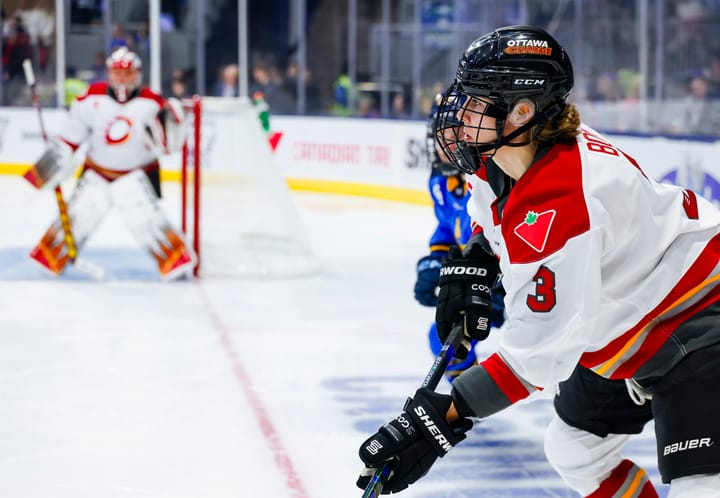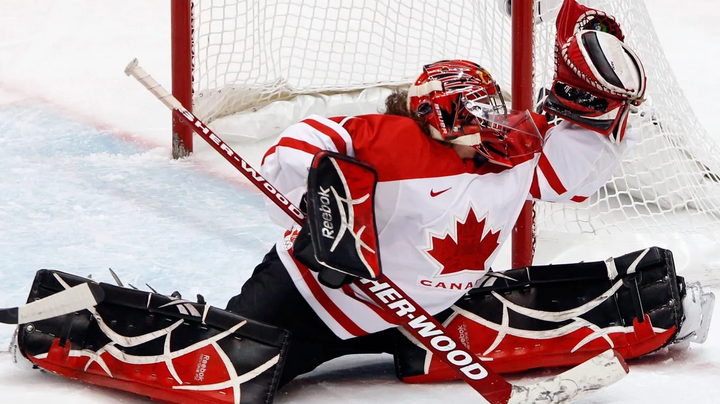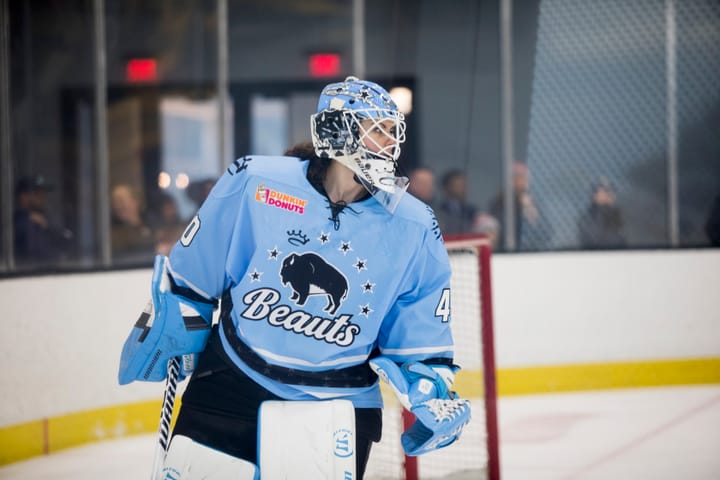Breaking down the PHF’s trans inclusion policy
The league updated its Transgender and Nonbinary Inclusion policy.
When the National Women’s Hockey League rebranded as the Premier Hockey Federation, there was an intentional removal of “Women’s” from their name. This served two purposes, the first of which being the social stigma of a women’s sports league being thought of as lesser than their male counterparts. When the only difference between the name of your league and the top men’s league is the word “women’s,” the comparisons are inevitable, as is the continual use of “women’s” as a modifier to all of your accomplishments.
This kind of feminism is complicated, as I don’t think we can remove misogynistic perceptions by removing the word entirely. However, on the other end of this spectrum of thought are trans-exclusionary politics that purposefully include the word “women” as a signal that only certain kinds of women are allowed in those spaces.
Which brings us to the second purpose the PHF’s rebrand serves: to make it clear to trans athletes — who have competed in both the NWHL and the now defunct Canadian Women’s Hockey League in the past, despite the leagues’ names — that they are welcome to compete among the best in the sport.
In a time where we’re seeing more and more anti-trans legislation and rulings, what trans athletes are asking for isn’t as superficial as a name change. Women’s spaces have historically been more welcoming to trans people than men’s spaces, as women’s spaces have also often overlapped with queer spaces. So while trans and nonbinary people aren’t a monolith, many of us have gotten used to navigating women’s spaces because that’s where we are welcomed. While the name change is still a net positive, what trans athletes really need is clear league policies that will guarantee their protection in those spaces.
I think it was a misstep by the PHF to launch this rebrand without a trans and nonbinary inclusion policy in place. It makes us feel like an afterthought, as though the name change was mostly to relieve the stigma of (cis) women’s accomplishments in hockey and not about our inclusion.
The league can’t change the fact that they jumped the gun here, expecting praise for their progressive stance when there was nothing in place to protect trans athletes. Moving forward, they’re already going to be a step behind.
The PHF released their Transgender and Nonbinary Inclusion policy on Oct. 15, more than five weeks after the announcement of their rebrand.
We’ll walk through each section of the policy below. View the policy in full on the PHF’s website here.
15.1 GUIDING PRINCIPLES
The PHF’s inclusion policy is guided by the following principles:
1. Inclusion, not exclusion, is at the core of our values as a league. Fairness in hockey and the inclusion of transgender and non-binary athletes do not have to be at odds with one another.
2. The PHF respects all backgrounds, experiences, and identities and assumes from the outset that athletes who compete under these rules are doing so to play hockey as who they truly are, not to gain a competitive advantage.
3. The PHF acknowledges the history of sport governing bodies scrutinizing transgender and non-binary athletes through policy that emphasizes medical gatekeeping. The aim of this policy is to offer guidance and support for all athletes and to center athlete health and safety at all times.
4. The PHF recognizes that gender expression and/or gender identity may or may not be the same as a person’s assigned sex and that gender identity exists beyond a binary system.
5. Gender affirming surgery is not required for an individual to participate in athletic competition and is not required by the PHF under any circumstances.
6. Each person is in control of the ways they present and express their gender, and as such, no person should have their identity disclosed without their express consent.
7. The implementation and administration of this policy will respect every athlete’s privacy and human rights.
8. The PHF recognizes the rapidly changing legal landscape for comprehensive nondiscrimination protections for transgender and non-binary people. Athletes are able to change identity documents and access gender-affirming care from earlier ages; as such, the PHF will maintain the privacy of all athletes.
9. The PHF acknowledges the inherent challenges in creating inclusive non-binary sport policy within a binary structure. The PHF will continue to evolve as the landscape of non-binary sport policy also evolves.
10. This policy may be modified, updated, or otherwise changed pending updated medical and expert guidance.
The policy begins with the league’s guiding principles with regard to gender inclusion. As someone who works in community building and enforcing inclusion guidelines, the language here is very well thought out.
In short, the league promises the right to privacy for trans athletes, acknowledges the reality of the changing legal landscape, clearly states that the league will not require gender-affirming surgery, nor will they participate in medical gatekeeping when it comes to trans athletes receiving care. They also acknowledge that, as nearly all league policies ultimately are, this is a living document that can be changed.
I think this is ultimately the best part of the policy — but that’s because there are sections that follow that contradict these fairly respectable goals.
Before I get to that, I would just add that this section is explicit in saying that gender-affirming surgery will not be a requirement (a good thing, as not all trans or nonbinary people want surgery or have access to a trustworthy doctor, or the finances involved, etc.), but there’s no mention of hormone replacement therapy (HRT) in the guiding principles. The policy with regards to HRT is more complicated and is certainly the reasoning behind the language about an ever-changing landscape, but acknowledging that the league believes trans athletes should have access to HRT (within the guidelines discussed below) shouldn’t be too controversial a stance to guide the league’s principles. Ultimately, that would’ve made this stronger.
I would also ask for clarification on exactly which medical professionals and experts they are consulting. This policy was formed in partnership with Athlete Ally and Hall of Fame transgender triathlete Chris Mosier, but is that where their medical advice is coming from as well? If the document is going to be living, it’s important to know whose hands will be shaping it in the future.
Section 15.2 is just a list of definitions for the rest of the policy. You can familiarize yourself with those definitions here, but I’d like to move on to Section 15.3.
15.3 ELIGIBILITY GUIDELINES
The PHF will use the below eligibility guidelines set out in this policy in order to ensure a fair and level playing field for all participants. The purpose of these guidelines is to create a clear pathway for the participation of both transgender and non-binary athletes in the PHF and to ensure the health, safety, and privacy of all athletes within the league are protected and respected.
TRANSGENDER ATHLETES
1. Transgender women are eligible to compete in the PHF if they have been living in their transgender identity for a minimum of two years.
2. Transgender men are eligible to compete in the PHF, but if they are taking testosterone for transition-related purposes, such use must be pursuant to a therapeutic use exemption as determined by the PHF, in consultation with the athlete’s physicians and applicable medical experts.
3. If an athlete who is currently playing in the PHF wants to come out as transgender, they are able to do so (see 15.4.2) as long as they are in compliance with the above eligibility guidelines.
NON-BINARY ATHLETES
1. A non-binary athlete assigned female at birth who is not undergoing medical intervention with testosterone is eligible to compete in the PHF.
2. A non-binary athlete assigned female at birth who is taking testosterone for transition-related purposes is eligible to compete in the PHF, but such use must be pursuant to a therapeutic use exemption as determined by the PHF in consultation with the athlete’s physicians and applicable medical experts.
3. A non-binary athlete assigned male at birth is eligible to compete in the PHF if they have been living in their non-binary identity for a minimum of two years, as affirmed by the athlete in consultation with the PHF.
4. If an athlete who is currently playing in the PHF wants to come out as non-binary, they are able to do so (see 15.4.2) as long as they are in compliance with the above eligibility guidelines.
All athletes are subject to the guidelines herein and other eligibility criteria of the PHF.
This policy is really rough because it contradicts the second guiding principle. If the league believes that trans and nonbinary athletes do not transition to gain a competitive advantage in sports (true), then why would the league set a minimum amount of time that an athlete has been “living in their transgender identity” before they can join the PHF? By its nature, this is a policy that is requiring athletes to “prove” their trans identity, something they shouldn’t have to do if you correctly believe trans athletes aren’t trying to pull one over on you.
That doesn’t even get into the vagueness of what it means to “live in your transgender identity.” Is that two years after talking it out with a therapist? Two years after the first time your gender expression matches your identity? Two years after the first person you came out to? Two years after starting HRT? Or will two years of social transitioning count? How will the league verify this while still respecting the athlete’s privacy?
That two-year requirement also means that trans women who aren’t out and have been playing in men’s leagues will likely have to take two years away from the sport. Two seasons is a long time, especially if the player is in their prime.
As for the HRT qualifications, it’s to be expected that they would have language allowing the league to essentially monitor the players’ use, as it is still considered a controlled substance in sports. On one hand, the vague language here could allow for the league to discriminate, but if read with the guiding principles in mind, that vague language is necessary because human bodies are all different and strict guidelines don’t allow for flexibility in medical decisions.
The problem is that they already went against the guiding principles in point number one, so that reading feels generous. Trans athletes are being asked to trust that the league will apply this policy in a way that protects them, despite the contradictions between the policy’s goals and mechanisms.
Finally, maintaining that a current player would have to meet the above conditions in order to come out raises a whole new bevy of questions about how they can meet guidelines for living in that identity for two years prior to the player ever coming out.
There’s not much clarification in the following sections, either.
15.4 PROCESS
1. An athlete may try out for the PHF based on their own determination of compliance with the Eligibility Guidelines. Athletes willing to disclose their identity may initiate the process by emailing the SVP of Hockey Operations Lisa Haley at lhaley@phfhq.com outlining their interest to participate in the PHF in accordance with the PHF Transgender and Non-Binary Player Inclusion Policy. Non-binary athletes assigned male at birth should also email lhaley@phfhq.com indicating their interest to participate in the PHF in accordance with the PHF Transgender and Non-Binary Player Inclusion Policy. The PHF may, upon receiving evidence that an athlete is not in compliance, ask for additional information.
2. Athletes currently competing in the PHF who wish to make changes to their gender identity, name, pronoun, or other markers within the League should contact the PHF to assist in making these changes on official publications and listings.
3. The PHF does not permit competition based on a fraudulent assertion of identity under any circumstances. If a player is found to be asserting a fraudulent identity, the PHF reserves the right to immediately remove a player from the league and, if necessary, take legal action.
The league asks players to determine for themselves if they meet the requirements listed in 15.3, but if “upon receiving evidence” that they don’t meet the eligibility requirements, the league can request more information. The vagueness of the policy listed is going to discourage trans athletes from pursuing an opportunity with the PHF.
And once again, the PHF is making sure they mention that only ‘real’ trans people are allowed. I know I’m a broken record on this, but you cannot say that trans athletes are inherently just trying to live as their authentic identity while also threatening legal actions if someone is found to be “faking it.”
Language allowing for people to get “caught” not being “trans enough” will ultimately result in exclusion of trans and nonbinary people who will feel like they are under a microscope due to this policy. The scrutiny of trans bodies and quantification of what it is to be trans and gender nonconforming is the problem and instead of eliminating it, the PHF simply formalized it.
15.6 YOUR ROLES AND RESPONSIBILITIES
All athletes are bound by the PHF Code of Conduct and this should be upheld at all times. However, specifically to this policy, all employees, members, volunteers, affiliate clubs, and Participants should:
1. Treat all transgender and non-binary athletes, employees, and individuals, with dignity and respect;
2. Welcome all transgender and non-binary individuals just as you would any other athlete, coach, employee, fan, volunteer, and/or member of the PHF community;
3. Accept all in the gender they present; verification of their identity should be no more than expected of any other person;
4. Ask the league office for additional resources and education on transgender and non-binary inclusion;
5. Respect the privacy of all transgender and non-binary individuals;
6. Report any incidents of inappropriate or offensive behavior and language to the Office of the Commissioner.
Section 15.5 relates to the privacy policy, and then the document closes out with personal responsibilities of all league athletes and employees. Again, we see the league state that no one can ask for verification of another player’s gender, but previous language leaves room for players to get reported for “fraudulent” transgender status.
A lot of factors go into the crafting of these policies, but the unfortunate reality that the PHF is contending with is the fact that they seem worried about alienating their anti-trans supporters. Including language that puts undue requirements on the lives and identities of trans athletes doesn’t serve to protect them, or their teammates or the league, for that matter.
It is only included to coddle the feelings of those who think that trans and nonbinary athletes are anything except people trying to live authentically.
If the guiding principles say one thing, but the policy mechanics say another, who is this policy for? Whose interests are protected in the end?





Comments ()